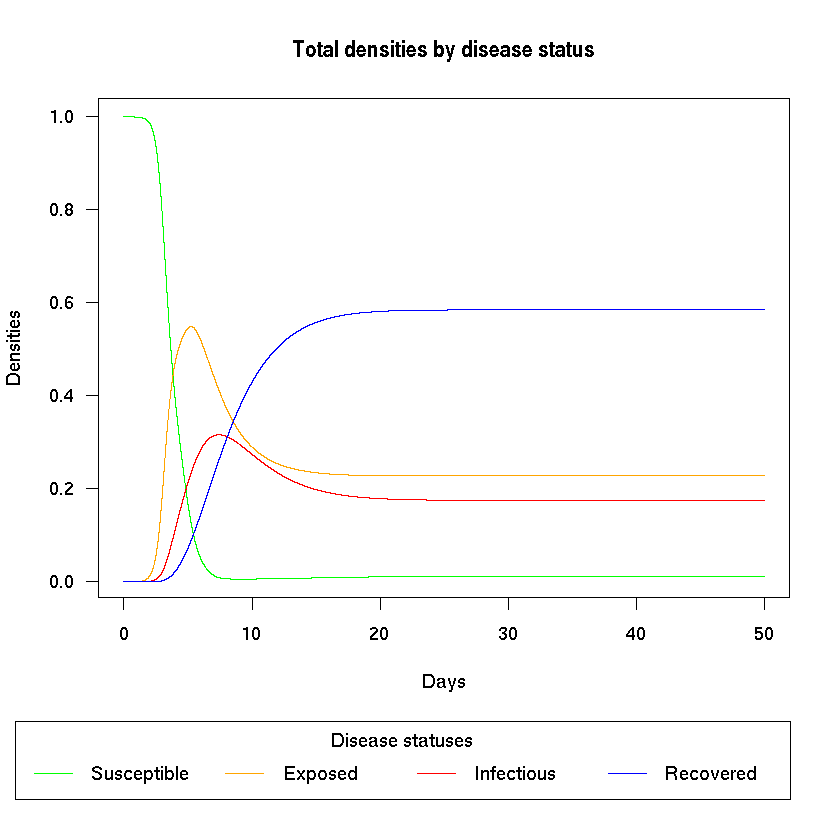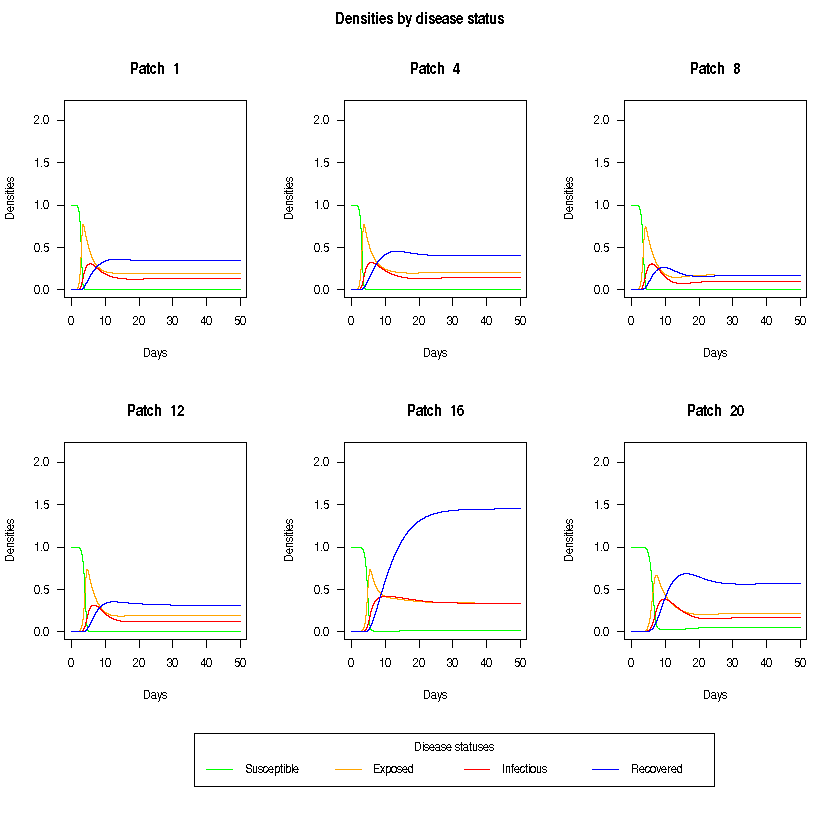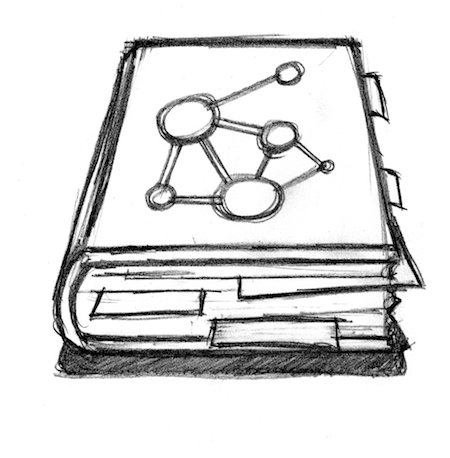Metapopulation SEIR model with cross-coupling and/or migration
Author: Constanze Ciavarella @ConniCia
Date: 2018-10-02
Requirements
To use odin, we need to install the package along with its dependencies. This is done using the following commands:
if (!require("drat")) install.packages("drat")
drat:::add("mrc-ide")
install.packages("dde")
install.packages("odin")
We also define the following helper functions:
# beta matrix: random initialisation -----------------------------------------------------
beta.mat <- function (nr_patches) {
## beta: positive, non-symmetric matrix of effective contact rates
## values are higher on the diagonal (transmission is higher *within*-patch),
## values decrease gradually further away from the diagonal (*between*-patch transmission)
beta <- matrix(0, nrow=nr_patches, ncol=nr_patches)
for (i in 0:(nr_patches-1)) {
## superdiagonal: scale vector s.t. numbers decrease further away from diagonal
rand.vec <- rnorm(nr_patches-i, 10 * (nr_patches-i)/nr_patches, 2)
beta[row(beta) == col(beta) - i] <- rand.vec
## subdiagonal
rand.vec <- rnorm(nr_patches-i, 10 * (nr_patches-i)/nr_patches, 2)
beta[row(beta) == col(beta) - i] <- rand.vec
}
return(beta)
}
# mobility matrix: random initialisation -----------------------------------------------------
mob.mat <- function (nr_patches) {
## mobility matrix (origin-destination matrix of proportion of population that travels) #TODO trip counts or relative?
C <- matrix(0, nrow=nr_patches, ncol=nr_patches)
if (nr_patches > 1) {
diag(C) <- -sample(1:25, nr_patches, replace=TRUE)
for (i in 1:nr_patches) {
C[i, which(C[i, ] == 0)] <- rmultinom(n = 1, size = -C[i,i], prob = rep(1, nr_patches-1))
}
C <- C/100
}
return(C)
}
# plotting --------------------------------------------------------------------#
plot.pretty <- function(out, nr_patches, what) {
# plot total densities by disease status --------------------------------------#
if (what == "total") {
## compute total densities by disease status
S_tot <- rowSums(out$S) / nr_patches
E_tot <- rowSums(out$E) / nr_patches
I_tot <- rowSums(out$I) / nr_patches
R_tot <- rowSums(out$R) / nr_patches
## plot total densities by disease status
par(mfrow=c(1, 1), las=1, omi=c(1,0,0,0), xpd=NA)
plot( t, S_tot, col="green",
type="l", xlab="Days", ylab="Densities",
main="Total densities by disease status")
lines(t, E_tot, col="orange")
lines(t, I_tot, col="red")
lines(t, R_tot, col="blue")
legend(-8.5, -0.3, title="Disease statuses", horiz=TRUE,
legend=c("Susceptible", "Exposed", "Infectious", "Recovered"),
col=c("green", "orange", "red", "blue"), lty=1)
}
# plot densities of some patches by disease status ----------------------------#
if (what == "panels") {
## define the plot panels
if (nr_patches >= 6) {
mfrow=c(2, 3)
panels <- as.integer( seq(1, nr_patches, length.out=6))
} else if (nr_patches >= 4) {
mfrow=c(2, 2)
panels <- as.integer( seq(1, nr_patches, length.out=4))
} else {
mfrow=c(1, nr_patches)
panels <- 1:nr_patches
}
par(mfrow=mfrow, las=1, omi=c(1,0,0.3,0), xpd=NA)
## plot the disease statuses of some patches
ymax <- max(out$N[, panels])
for (i in panels) {
plot (t, out$S[, i], col="green", ylim=c(0, ymax),
type="l", xlab="Days", ylab="Densities",
main=paste("Patch ", i))
lines(t, out$E[, i], col="orange")
lines(t, out$I[, i], col="red")
lines(t, out$R[, i], col="blue")
}
title("Densities by disease status", outer=TRUE)
legend(-130, -1.2, title="Disease statuses", horiz=TRUE,
legend=c("Susceptible", "Exposed", "Infectious", "Recovered"),
col=c("green", "orange", "red", "blue"), lty=1)
}
}
The model is specified in odin as:
SEIR_cont <- odin::odin({
nr_patches <- user()
n <- nr_patches
## Params
lambda_prod[ , ] <- beta[i, j] * I[j]
lambda[] <- sum(lambda_prod[i, ]) # rowSums
mob_prod[ , ] <- S[i] * C[i, j]
mob_S[] <- sum(mob_prod[, i]) # colSums
mob_prod[ , ] <- E[i] * C[i, j]
mob_E[] <- sum(mob_prod[, i])
mob_prod[ , ] <- I[i] * C[i, j]
mob_I[] <- sum(mob_prod[, i])
mob_prod[ , ] <- R[i] * C[i, j]
mob_R[] <- sum(mob_prod[, i])
N[] <- S[i] + E[i] + I[i] + R[i]
output(N[]) <- TRUE
## Derivatives
deriv(S[]) <- mu - mu*S[i] - S[i]*lambda[i] + M[1] * mob_S[i]
deriv(E[]) <- S[i]*lambda[i] - (mu + sigma) * E[i] + M[2] * mob_E[i]
deriv(I[]) <- sigma*E[i] - (mu + gamma)*I[i] + M[3] * mob_I[i]
deriv(R[]) <- gamma*I[i] - mu*R[i] + M[4] * mob_R[i]
## Initial conditions
initial(S[]) <- 1.0 - 1E-6
initial(E[]) <- 0.0
initial(I[]) <- 1E-6
initial(R[]) <- 0.0
## parameters
beta[,] <- user() # effective contact rate
sigma <- 1/3 # rate of breakdown to active disease
gamma <- 1/3 # rate of recovery from active disease
mu <- 1/10 # background mortality
C[,] <- user() # origin-destination matrix of proportion of population that travels
M[] <- user() # relative migration propensity by disease status
## dimensions
dim(beta) <- c(n, n)
dim(C) <- c(n, n)
dim(M) <- 4
dim(lambda_prod) <- c(n, n)
dim(lambda) <- n
dim(mob_prod) <- c(n, n)
dim(mob_S) <- n
dim(mob_E) <- n
dim(mob_I) <- n
dim(mob_R) <- n
dim(S) <- n
dim(E) <- n
dim(I) <- n
dim(R) <- n
dim(N) <- n
})
gcc -I/usr/local/lib/R/include -DNDEBUG -I/usr/local/include -fpic -g -O2 -c odin.c -o odin.o
g++ -shared -L/usr/local/lib/R/lib -L/usr/local/lib -o odin_b0e443ee.so odin.o -L/usr/local/lib/R/lib -lR
Running the model
We first define the user-specified parameters. The default values provided below all satisfy model requirements, but can be changed if needed.
# set seed
set.seed(1)
# SEIR free parameters --------------------------------------------------------#
## total number of patches in the model
nr_patches = 20
## relative migration propensity by disease status (S, E, I, R)
M <- c(1, 0.5, 1, 1)
## matrix of effective contact rates
beta <- beta.mat(nr_patches)
## mobility matrix
C <- mob.mat(nr_patches)
Now we run the model. Note that each patch is initialised with the same population size. We also run a test to make sure that the total population size has remained constant throughout the simulation.
# run SEIR model --------------------------------------------------------------#
mod <- SEIR_cont(nr_patches=nr_patches, beta=beta, C=C, M=M)
t <- seq(0, 50, length.out=50000)
out <- mod$run(t)
out <- mod$transform_variables(out)
# error check -----------------------------------------------------------------#
if ( ! all( abs(rowSums(out$N) - nr_patches) < 1E-10 ) )
warning("Something went wrong, density is increasing/decreasing!\n")
Now we can plot the disease dynamics in the total population.
# plot total densities by disease status --------------------------------------#
plot.pretty(out, nr_patches, "total")

We can also plot the disease dynamics of some of the patches. Dynmics between patches may vary due to cross-coupling and migration rates.
# plot densities of some patches by disease status ----------------------------#
plot.pretty(out, nr_patches, "panels")

